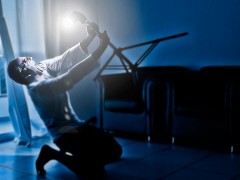
Photography is all about light. Photography means capturing light. Lighting is one of the most important aspects of the art and a good understanding of light and it’s nature is essential for getting the pictures that you want. Let’s start with understanding the features of light in this post. Once you know about the features of lighting you can learn about various lighting techniques here. For now, let’s begin with the fundamentals of lighting, i.e. light and its features.
-
Temperature
The white light that you see always has a color cast. Our eyes are good at adjusting to the neutral color that they neglect any color cast in the light and see it as white. The color temperature affects the picture in various ways sometimes bringing an overall reddish tinge to the picture and greenish or bluish at other times. Good cameras thus features a White-Balance control to compensate for the unwanted color cast to bring out the original colors for accurate rendition. White-balance has been covered in another post and you can read more about white-balancing here.
-
Quality
There’s nothing as good and bad. It’s the nature of the light that you employ to get a desired effect. We have this in two flavors hard-light and soft-light. Hard light is more focused and harsh in nature wherein the shadows come out with defined and sharp edges. A soft light is a diffused or more evenly spread light that renders shadows as soft shades bringing a glow to the subject. Depending on the requirement and the mood you want to bring to the picture you can use hard or soft light. Portraits especially fashion and glamor photos call for soft lighting wherein the models are bathed in a soft glow. At other times you may want to bring a special mood to the subject by intelligent use of hard light for a particular purpose. The resulting image will have defined shadows depending on the direction of the light.
-
Quantity
Again nothing good or bad here too. But I always favor more light than less. Light is just the playground for the camera and your imaginations. The more you have (and depending on your equipment) the more you can control to bring in the desired effect. More light is mandatory for shooting sports because you want to have enough of it to allow high shutter speed and freeze the action. Less of it shows very well and comes out beautiful when you have a tripod and you are shooting city streets at night. A low ISO with a long exposure is just what you need to see the beauty of city lighting at night. Apparently the camera is designed to take care of the exposure with minimal impact by the amount of light incoming. But actually, amount of light does matter. See how.
-
Direction Of Light
Very important. You can throw the light from down under the chin to get a horror effect. Or employ side light for adding drama.
-
Type Of Light
This pertains to the equipment you employ to get the type of light you want. The ambient light or flash or a combination of both is used to get a desired effect. Using a flash on back-lit scenes wherein the subject is generally underexposed is just one example of using the type of light to achieve a desired effect.
I’ll summarize the information that you take back from this article and repeat that knowing the light is very important. Start by keeping it simple. There are five things – temperature, quality, quantity, direction and type. Temperature induces the color, white-balance corrects it; quality is hard and soft, quantity is the playground of the camera, direction gives the mood and type pertains to the equipment you employ to get the light. And now your comments :)


So glad I found this website. It’s been a BIG help.
Thanx, for the summary… On lighting. I picked up some great tips from this article. I am very pleased I subscribe to this site, it’s been a great help to my photography hobby…
MarieLouise…